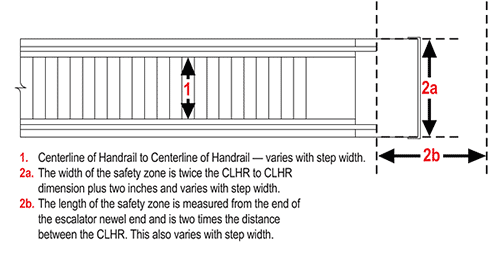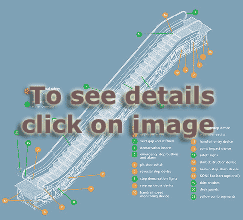Escalator Basics Today: How to Plan, Design and Update
The width of the escalator pit is typically calculated as the physical width of the escalator plus two inches to allow for construction tolerance. Side by side escalators are typically handled the same way, but the two inches is added only once, not per escalator.
Code stipulates the width and the length of the landing zone at each end of the escalator, both of which are driven by the distance between the centerline of the handrails (CLHR.) This varies with step width and among manufacturers.
Â
| Code Clearances |
 |
Source: KONE Inc. |
Â
Standard escalator features. Most escalator manufacturers offer the following basic standard features:
Balustrades in "solid" usually #4 or #8 stainless steel and bronze or glass with thickness either 3/8" or 1/2".
Speed. 100 ft per minute, which is the maximum speed.
Step widths in 24-in, 32-in and 40-in.
Microprocessor based controller.
Maximum travel distance varies with manufacturer.
Painted steps in silver and black
High-impact step inserts in yellow and black
Floor Plate in aluminum and stainless steel
Safety features. (See Safety Features sidebar below.)
ESCALATOR PLANNING
The essential feature of escalator planning is to understand that there is no one-solution-fits-all. Each project needs to be analyzed according to its particular requirements.
Applications for Escalators with Different Step Widths |
||||
Size |
Step Width |
Single-step capacity |
Applications |
Energy consumption in Horsepower |
Small |
24 in |
One passenger |
Two passengers - one may walk past another |
5 HP |
Medium |
32 in |
One passenger + one package or one piece of luggage |
Two passengers - one may walk past another |
10 HP |
Large |
40 in |
Two passengers - one may walk past another |
Mainstay of metro systems, larger airports, train stations, some retail usage |
15 HP |
Â
The first place to start is analyzing the market segment. Retail, office, airport, stadium, hospital or public transit, each require different features and design aesthetics. Some site-driven features include:
- Type of balustrade. In addition to standard manufacturer offerings stainless steel, bronze and glass, detailing in brass and ambient glass are available.
- Step width is specified according to space available and the requirements of passengers.
- Number of flat steps. Code requires a minimum of two flat steps. Most commercial projects are designed for two flat steps. Three flat steps is a common feature found in public transportation projects.
- Weather related features. Water resistant options include galvanized trusses, water tight control cabinets and electrical switches, sealed bearings, chain covers, and protective canopies. These are common in outdoor applications.
- Type of chain. Lubricated chain or lubrication free chain are options. Depending on the rise, width, and step loading requirements, chain will be sized accordingly.
- Type of metal finish. 304 type steel is standard. 316 is an available option for corrosion resistance.
- Type of drive and other components. Planetary gear drives are standard. Energy saving soft start devices are optional.
Since many of these features can add considerable cost to the escalator budget, it is important to take time to match the operating environment with the required features prior to finalizing the project budget and specification.
Â










